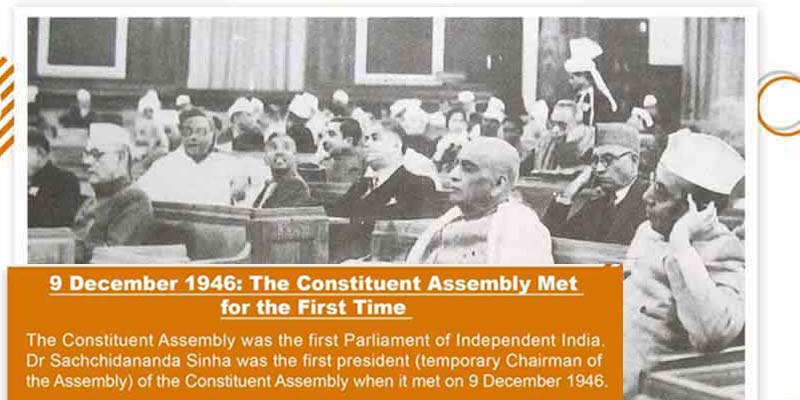- India
- Dec 09
- Kevin Savio Antony
First meeting of Constituent Assembly of India
Rajya Sabha Chairman Jagdeep Dhankhar highlighted that the Constituent Assembly’s first session was held on December 9, 1946 and sought to remind the members that they should lay very high standards in parliamentary proceedings.
Dhankar described it as the beginning of the monumental task of drafting the Constitution of India.
Constituent Assembly
The evolution of the Constituent Assembly of India is rooted in a series of historical developments:
• M.N. Roy’s Proposal: The idea of a constituent assembly was first proposed by M.N. Roy in 1934. He argued for the need for a body to draft a constitution that truly reflected the aspirations of Indians.
• INC’s Official Demand: The Indian National Congress officially demanded the establishment of a constituent assembly in 1935, emphasizing the need for Indians to frame their own constitution.
• Jawaharlal Nehru’s Statement (1938): In a defining moment, Jawaharlal Nehru declared that “The constitution of free India must be framed, without outside interference, by a constituent assembly elected on the basis of adult franchise.” This set the tone for India’s constitutional development.
• The August Offer (1940): For the first time, the British government acknowledged the possibility of a constituent assembly through the August Offer, although it did not provide immediate action.
• Cabinet Mission Plan (1946): The establishment of the Constituent Assembly was finally formalised under the provisions of the Cabinet Mission Plan, marking the transition toward drafting the Constitution of independent India.
• The first sitting of the Constituent Assembly was held on December 9, 1946, after its constitution on December 6, 1946.
Composition
• The Constituent Assembly was a partly elected and a partly nominated body.
• The members were elected indirectly by people in the provincial assemblies, who in turn had been elected on the basis of a limited franchise (on the basis of tax, property and education).
• It was an indirectly elected body and comprised representatives of all sections of Indian society. Further, the Constituent Assembly included all leading personalities of India of the time, with the exception of Mahatma Gandhi and Muhammad Ali Jinnah.
• The first meeting of the Constituent Assembly was chaired by Dr. Sachchidananda Sinha, who was then the oldest Member and also the oldest parliamentarian in India, having served as a Member of the Imperial Legislative Council from the year 1910 and also in the Central Legislative Assembly from 1921.
• Under the leadership of stalwarts such as Dr. Rajendra Prasad, Dr. B.R. Ambedkar, Jawaharlal Nehru, and Sardar Vallabhbhai Patel, the Assembly undertook the monumental task of debating and drafting provisions that would guide the destiny of an independent India.
Important Committees of Constituent Assembly and Their Chairmen:
• Committee on the Rules of Procedure: Rajendra Prasad
• Steering Committee: Rajendra Prasad
• Finance and Staff Committee: Rajendra Prasad
• Credential Committee: Alladi Krishnaswami Ayyar
• House Committee: B. Pattabhi Sitaramayya
• Ad hoc Committee on the National Flag: Rajendra Prasad
• Committee on the Functions of the Constituent Assembly: G.V. Mavalankar
• Order of Business Committee : K.M. Munsi.
(The author is a trainer for Civil Services aspirants.)

